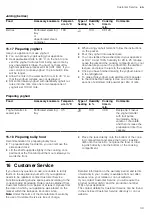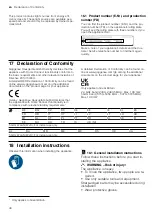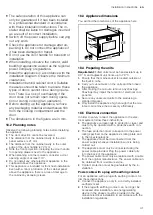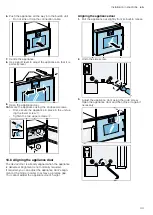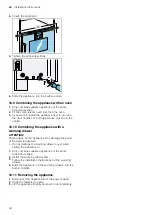
How it works
en
29
15.8 Sous-vide cooking
When sous-vide cooking, you cook the food under a
vacuum at low temperatures between 50 and 95 °C
and at 100% steam.
WARNING ‒ Risk of harm to health!
Due to the low sous-vide cooking cooking temperat-
ures, there is a risk to health if you do not follow the in-
structions for use and hygiene instructions below.
▶
Use only fresh, good-quality food.
▶
Wash and disinfect your hands. Use disposable
gloves or grill tongs.
▶
Take extra care when preparing critical food, such
as poultry, eggs and fish.
▶
Always thoroughly rinse and/or peel fruit and veget-
ables where necessary.
▶
Always keep work surfaces and chopping boards
clean. Use different chopping boards for different
types of food.
▶
Maintain the cold chain. Only interrupt the cold
chain briefly to prepare the food. Store vacuum-
sealed food back in the refrigerator until it is ready
to be cooked.
▶
The food is suitable for immediate consumption
only. Once the food is cooked, consume it immedi-
ately. Do not store it after cooking. Do not store the
food in the refrigerator either. The food is not suit-
able for reheating.
¡
With this operating mode, no preheating is neces-
sary.
¡
Sous-vide cooking is a gentle, low-fat method of
cooking meat, fish, vegetables and desserts. A va-
cuum-sealing machine uses heat to hermetically
seal the food in a special heat-resistant cooking
bag.
¡
The protective envelope retains the nutrients and fla-
vours. The low temperatures and the direct heat
transfer help you to achieve precisely controlled
cooking in order to achieve the desired cooking res-
ults. It is almost impossible to overcook the food.
¡
Use the portion sizes listed in the cooking table. For
larger quantities and items, adjust the cooking time
accordingly. The portions specified for fish, meat
and poultry correspond to a single serving. The por-
tions specified for vegetables and desserts corres-
pond to servings for 4 people.
¡
You can cook on up to two levels. Slide the cooking
containers in at levels 1 and 3 to achieve the best
cooking results. If you are cooking on just one level,
use level 2.
¡
When using the sous-vide cooking method, only use
heat-resistant vacuum-sealing bags designed for
this purpose. Do not cook the food in the vacuum-
sealing bag in which you bought the food, e.g. por-
tioned fish. These bags are not suitable for sous-
vide cooking.
¡
To ensure an even transfer of heat and a perfect
cooking result, use a chamber vacuum-sealing ma-
chine that can create a 99% vacuum when vacuum-
sealing food.
Vacuum-sealing
When vacuuming, heat-seal the food in a special
plastic bag so that it is airtight.
Note the following points when vacuum-sealing:
¡
There is no/hardly any air in the vacuum-sealing
bag.
¡
The heat-sealed seam is perfectly sealed.
¡
The vacuum-sealing bag has no holes in it. Do not
use a core temperature probe.
¡
Pieces of meat or fish that have been vacuum-
sealed together are not pressed directly against one
another.
¡
You have vacuum-sealed vegetables and desserts
as flat as possible.
Before cooking the food, check whether the vacuum in
the bag is intact.
If in doubt, place the food into a new bag and vacuum-
seal it again. Vacuum-seal food no more than one day
before the cooking process. This is the only way to pre-
vent the escape of gases from the food (e.g. from ve-
getables) which inhibit the transfer of heat, or to pre-
vent the texture of the food from changing, and thus al-
tering how it cooks, as a result of the vacuum pressure.
Quality of the food
The quality of the cooking result is 100% influenced by
the quality of the ingredients you use.
Use only fresh, top-quality food. This is the only way to
guarantee a consistent cooking result that delivers im-
peccable flavour.
Cooking
Sous-vide cooking prevents flavours from escaping, in-
tensifying the food's natural flavour. Note that the usual
quantities of seasoning and condiments, such as
herbs, spices and garlic, will have a much greater ef-
fect on the flavour. Start off by halving the quantities
you usually use.
If the ingredients are of high quality, it is often sufficient
to enclose them in the bag with just a small knob of
butter and a little salt and pepper. Generally, the fact
that the food's natural flavours intensify during cooking
is sufficient on its own to produce a flavourful cooking
result.
Do not place the vacuum-sealed food items on top of
one another or too close together in the cooking con-
tainers. In order to ensure even heat distribution, make
sure that you do not touch the food. If you have more
than one vacuum-sealing bag, cook on two levels.
Remove the vacuum-sealing bags with care after cook-
ing, as hot water accumulates on the bags. Place the
unperforated cooking container into the cooking com-
partment at the level below the perforated cooking con-
tainer containing the hot food.
Dry the outside of the bag, place it into a clean, unper-
forated cooking container and cut it open with scissors.
Place all of the food, along with its juices, into the
cooking container.
The food can be finished off as follows once the sous-
vide cooking stage is complete:
¡
Vegetables: Flash fry in a frying pan or on the tep-
pan yaki to give them the flavours you would expect
from frying. In doing so, you can effortlessly season
the vegetables or mix them with other ingredients
without the vegetables cooling down.
¡
Fish: Season and coat with hot butter. Since many
types of fish fall apart easily after cooking using the
sous-vide method, if you want to flash fry fish, this
Содержание BSP2201.1
Страница 1: ...en User manual and installation instructions BSP2201 1 BSP2211 1 Steamer Gaggenau ...
Страница 45: ......
Страница 46: ......
Страница 47: ......

























